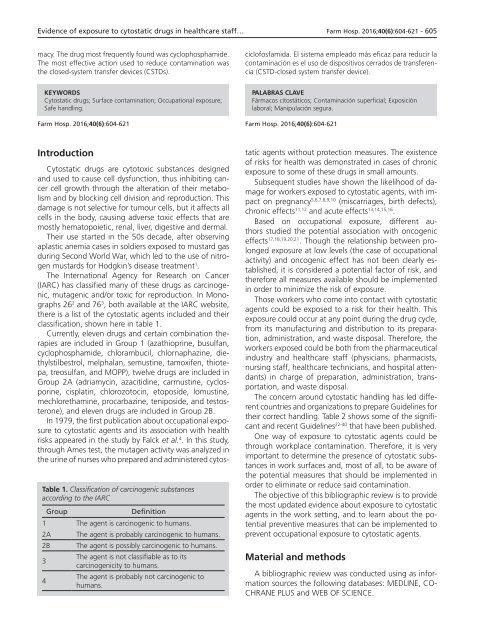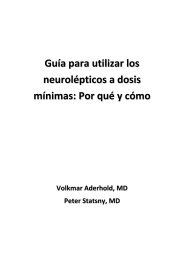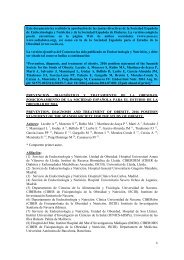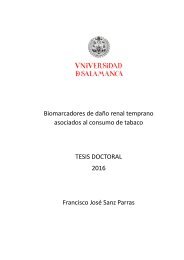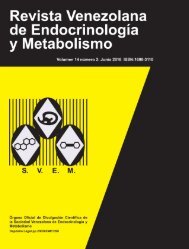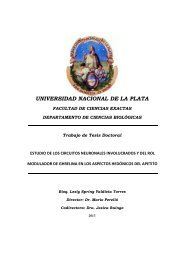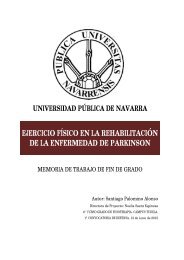Noviembre-Diciembre
156_v40n6(1)
156_v40n6(1)
You also want an ePaper? Increase the reach of your titles
YUMPU automatically turns print PDFs into web optimized ePapers that Google loves.
Evidence of exposure to cytostatic drugs in healthcare staff… Farm Hosp. 2016;40(6):604-621 - 605<br />
macy. The drug most frequently found was cyclophosphamide.<br />
The most effective action used to reduce contamination was<br />
the closed-system transfer devices (CSTDs).<br />
ciclofosfamida. El sistema empleado más eficaz para reducir la<br />
contaminación es el uso de dispositivos cerrados de transferencia<br />
(CSTD-closed system transfer device).<br />
KEYWORDS<br />
Cytostatic drugs; Surface contamination; Occupational exposure;<br />
Safe handling.<br />
Farm Hosp. 2016;40(6):604-621<br />
PALABRAS CLAVE<br />
Fármacos citostáticos; Contaminación superficial; Exposición<br />
laboral; Manipulación segura.<br />
Farm Hosp. 2016;40(6):604-621<br />
Introduction<br />
Table 1. Classification of carcinogenic substances<br />
according to the IARC<br />
Group<br />
Definition<br />
1 The agent is carcinogenic to humans.<br />
2A The agent is probably carcinogenic to humans.<br />
2B The agent is possibly carcinogenic to humans.<br />
The agent is not classifiable as to its<br />
3<br />
carcinogenicity to humans.<br />
The agent is probably not carcinogenic to<br />
4<br />
humans.<br />
Cytostatic drugs are cytotoxic substances designed<br />
and used to cause cell dysfunction, thus inhibiting cancer<br />
cell growth through the alteration of their metabolism<br />
and by blocking cell division and reproduction. This<br />
damage is not selective for tumour cells, but it affects all<br />
cells in the body, causing adverse toxic effects that are<br />
mostly hematopoietic, renal, liver, digestive and dermal.<br />
Their use started in the 50s decade, after observing<br />
aplastic anemia cases in soldiers exposed to mustard gas<br />
during Second World War, which led to the use of nitrogen<br />
mustards for Hodgkin’s disease treatment 1 .<br />
The International Agency for Research on Cancer<br />
(IARC) has classified many of these drugs as carcinogenic,<br />
mutagenic and/or toxic for reproduction. In Monographs<br />
26 2 and 76 3 , both available at the IARC website,<br />
there is a list of the cytostatic agents included and their<br />
classification, shown here in table 1.<br />
Currently, eleven drugs and certain combination therapies<br />
are included in Group 1 (azathioprine, busulfan,<br />
cyclophosphamide, chlorambucil, chlornaphazine, diethylstilbestrol,<br />
melphalan, semustine, tamoxifen, thiotepa,<br />
treosulfan, and MOPP), twelve drugs are included in<br />
Group 2A (adriamycin, azacitidine, carmustine, cyclosporine,<br />
cisplatin, chlorozotocin, etoposide, lomustine,<br />
mechlorethamine, procarbazine, teniposide, and testosterone),<br />
and eleven drugs are included in Group 2B.<br />
In 1979, the first publication about occupational exposure<br />
to cytostatic agents and its association with health<br />
risks appeared in the study by Falck et al. 4 . In this study,<br />
through Ames test, the mutagen activity was analyzed in<br />
the urine of nurses who prepared and administered cytostatic<br />
agents without protection measures. The existence<br />
of risks for health was demonstrated in cases of chronic<br />
exposure to some of these drugs in small amounts.<br />
Subsequent studies have shown the likelihood of damage<br />
for workers exposed to cytostatic agents, with impact<br />
on pregnancy 5,6,7,8,9,10 (miscarriages, birth defects),<br />
chronic effects 11,12 and acute effects 13,14,15,16 .<br />
Based on occupational exposure, different authors<br />
studied the potential association with oncogenic<br />
effects 17,18,19,20,21 . Though the relationship between prolonged<br />
exposure at low levels (the case of occupational<br />
activity) and oncogenic effect has not been clearly established,<br />
it is considered a potential factor of risk, and<br />
therefore all measures available should be implemented<br />
in order to minimize the risk of exposure.<br />
Those workers who come into contact with cytostatic<br />
agents could be exposed to a risk for their health. This<br />
exposure could occur at any point during the drug cycle,<br />
from its manufacturing and distribution to its preparation,<br />
administration, and waste disposal. Therefore, the<br />
workers exposed could be both from the pharmaceutical<br />
industry and healthcare staff (physicians, pharmacists,<br />
nursing staff, healthcare technicians, and hospital attendants)<br />
in charge of preparation, administration, transportation,<br />
and waste disposal.<br />
The concern around cytostatic handling has led different<br />
countries and organizations to prepare Guidelines for<br />
their correct handling. Table 2 shows some of the significant<br />
and recent Guidelines 22-40 that have been published.<br />
One way of exposure to cytostatic agents could be<br />
through workplace contamination. Therefore, it is very<br />
important to determine the presence of cytostatic substances<br />
in work surfaces and, most of all, to be aware of<br />
the potential measures that should be implemented in<br />
order to eliminate or reduce said contamination.<br />
The objective of this bibliographic review is to provide<br />
the most updated evidence about exposure to cytostatic<br />
agents in the work setting, and to learn about the potential<br />
preventive measures that can be implemented to<br />
prevent occupational exposure to cytostatic agents.<br />
Material and methods<br />
A bibliographic review was conducted using as information<br />
sources the following databases: MEDLINE, CO-<br />
CHRANE PLUS and WEB OF SCIENCE.


